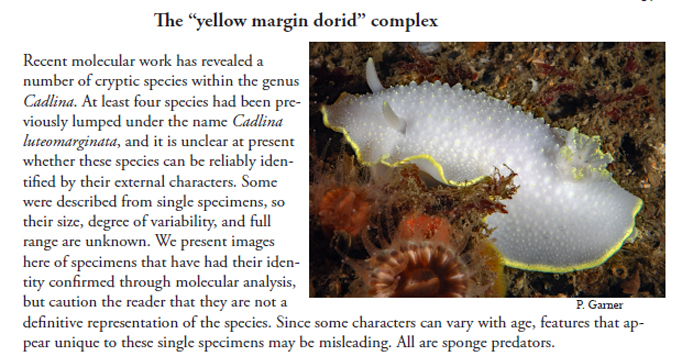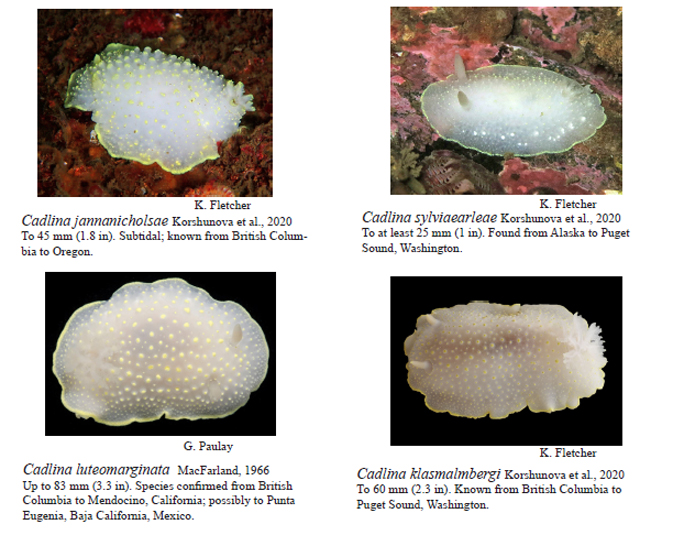By Greg Jensen and Karin Fletcher
While preparing the description of what had been a single species of white Cadlina with a yellow margin, historically called Cadlina luteomarginata, we realized we had a problem if we expected readers to be able to ID the species because there are now four described "yellow-margin dorid" species that are practically indistinguishable externally. The photo below represents the species complex, but even we can't determine whether the Cadlina in this photo is the true Cadlina luteomarginata or one of the other species.

|
The three new look-a-likes were known to be genetically distinct as far back as 2011 (Johnson, R., 2011) but not described or named until 2020 (Korshunova, et. al., 2020).
The photo below shows the group of four in this complex.

|
However, too few specimens were examined in the 2020 paper to develop a key for identifying the four species externally so we can only state that there are four described species. Also, since that paper was published there now appears to be a fifth species within this complex as seen in this tree adapted from one generated from BOLD. (The Barcode of Life Data System (BOLD) is an informatics workbench aiding the acquisition, storage, analysis and publication of DNA.)

|
References:
JOHNSON, R. F. 2011. Breaking family ties: taxon sampling and molecular phylogeny of chromodorid nudibranchs (Mollusca, Gastropoda). Zoologica Scripta 40(2): 137-157.
KORSHUNOVA, T., FLETCHER, K., PICTON, B., LUNDIN, K., KASHIO, S., SANAMYAN, N., SANAMYAN, K., PADULA, V., SCHRÖDL, M., MARTYNOV, A. 2020. The Emperor's Cadlina, hidden diversity and gill cavity evolution: new insights for the taxonomy and phylogeny of dorid nudibranchs (Mollusca: Gastropoda). Zoological Journal of the Linnean Society 20: 1-66.
Sammamish, WA 98074
July., 2022
Send Dave email at davidwbehrens@gmail.com
Image courtesy of Greg Jensen

His books are available through Amazon, or better yet, his website (www.molamarine.com). Greg's camera equipment: Olympus EM-5 in Olympus housing and Sea & Sea YS-01 strobe; kit lens
Send Greg email at gjensen@uw.edu |
Photo courtesy of Doug Miller

Karin Fletcher and her husband, Doug Miller, have been scuba diving in Puget Sound since 2006. In 2009, they moved to a house on Rich Passage near Bremerton, WA where they dive at least once a week, sometimes while dodging boat traffic. Karin has been tracking nudibranch abundance and diversity in Rich Passage since then and Doug tracks fish and invertebrates for REEF.org. Karin uses an Olympus TG-5 in an Olympus housing.
Send Karin email at karin@milltech.com |
